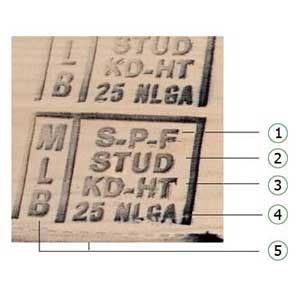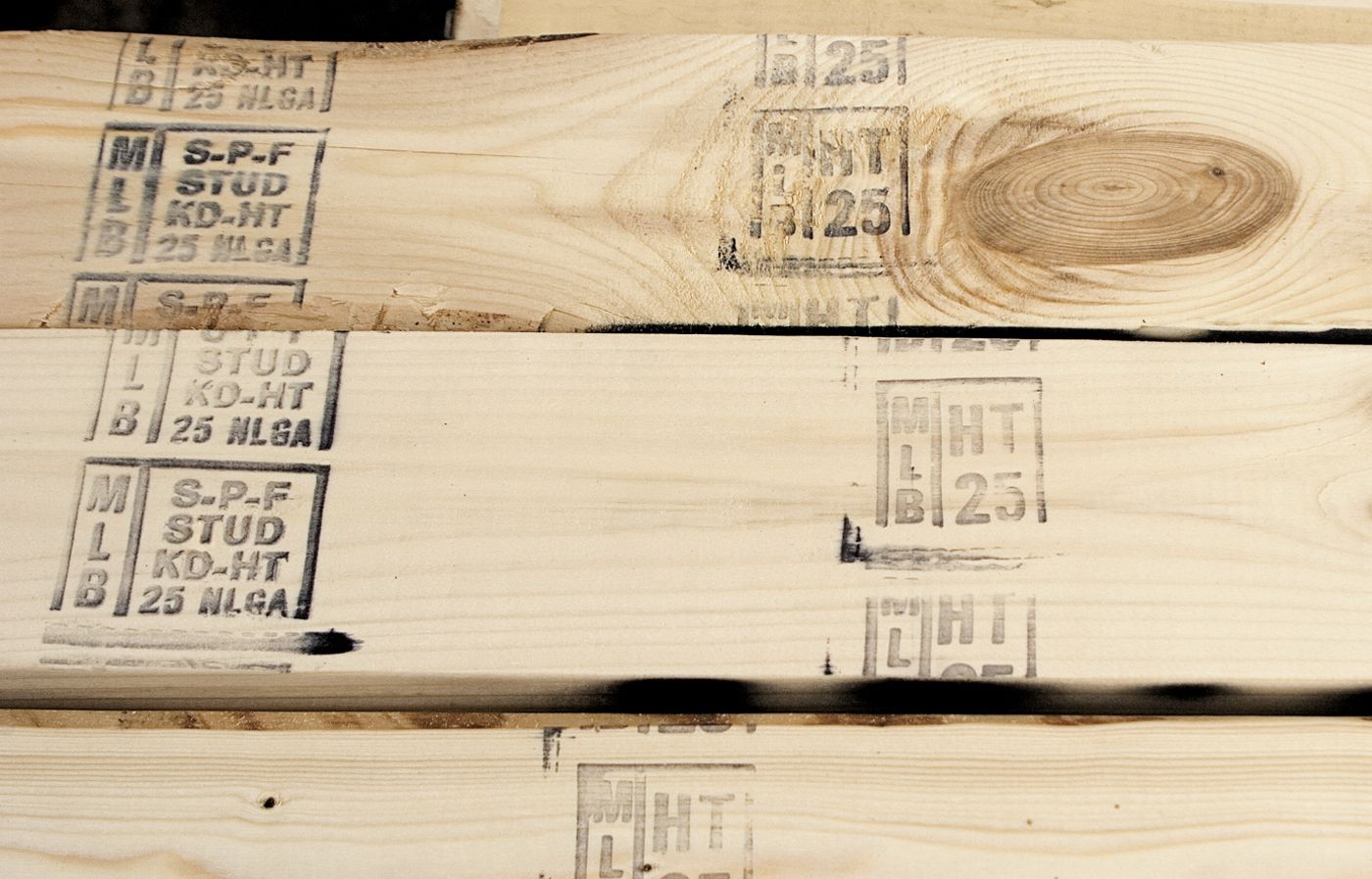If you’ve done any woodworking, odds are you’ve realized that not all lumber is created equally. Manufacturers create some types of lumber for specific projects, including kiln-dried heat-treated (KDHT) wood. This wood has unique characteristics, and you can use it in a number of ways. In our article, we’ll explore the uses and benefits of KDHT wood, compare it to other lumber, and explain how to read lumber-grade stamps.
What Is KDHT Wood?
KDHT wood is lumber that undergoes two processes—kiln drying and heat treatment. These procedures strengthen the wood so that you can use it in several ways and manufacturers can ship it internationally.
Defining KD and HT in Lumber
KD stands for kiln-dried. This means that the manufacturer has dried the wood in a controlled environment to lower its moisture content. HT means heat treatment, which refers to a process in which the wood is exposed to high temperatures to get rid of pests and pathogens.
The Process of Kiln Drying and Heat Treating
To kiln dry the wood, manufacturers place it in a large oven-like chamber. The temperature and humidity are set so that the wood’s moisture content is lowered to between 16% and 19%. This makes the lumber more stable so it won’t warp or shrink.
After the kiln drying takes place, the lumber is heat treated. Manufacturers heat the wood to a core temperature of at least 133 degrees Fahrenheit for a minimum of 30 minutes. When the wood is heated to such a high degree, it kills off any insects, larvae, or eggs that may have been inside the wood.
Benefits of Using KDHT Wood
When you compare KDHT wood to untreated or green lumber, there are a few reasons why some prefer it over other options. Here are some advantages of KDHT wood:
- Enhanced appearance: Because of the kiln and heat treatments, KDHT looks more refined and is aesthetically pleasing over other lumber types.
- Improved stability and strength: Since kiln drying reduces the lumber’s moisture content, it won’t warp, twist, or shrink. This makes it stronger and more stable than other wood types, and contractors like it because they know they can depend on accurate measurements for their construction projects.
- Pest resistance and international compliance: As we mentioned earlier, when the KDHT wood is heated at high temperatures, it eliminates pests. This means the lumber has met certain shipping standards and is in compliance to prevent the spread of invasive species across borders.
How To Read Lumber-Grade Stamps

Have you ever noticed the stamps on the lumber you find at home improvement stores? Those markings represent the lumber’s properties and quality. We’ll go over the different lumber-grade stamps and their meanings below so that you have a better understanding of what these stamps mean to help you choose the right lumber for your project.
Decoding Species Information
The species code on a grade stamp points to the wood type or species group with the same strengths. For example:
- Doug Fir or D Fir-L: Douglas fir (L stands for western larch)
- Hem or Hem-fir: Hemlock or fir
- S-P-F: Spruce, pine, or fir
- SYP: Southern pine
Understanding Moisture Content Labels
The moisture content labels on lumber-grade stamps tell you how the wood was dried. Here’s a breakdown:
- AD or S-GRN: Air-dried or surface-green, with a moisture content of 19% or more
- KD or S-DRY: Kiln-dried or surface-dry, with a moisture content between 16% and 19%
- KD-HT: Kiln-dried and heat-treated
- MC-15: Moisture content of 15% or less
Interpreting Grade Designations
This Old House’s general contractor Tom Silva says he’ll pay extra for stronger wood grades when he’s working on more demanding projects, such as constructing interior load-bearing walls.
The grade rating below describes the wood’s quality based on visual inspection:
- No. 1: High quality with good strength
- No. 2: Good strength at a reasonable price
- No. 3: Lowest strength, not as visually appealing
- Select Structural: Highest strength and best appearance
- Stud: Suitable for load-bearing walls
KDHT Wood vs. Other Lumber Types
Now that you know a bit more about KDHT wood, we’ll compare them to other lumber types so that you can choose the right one for your project.
KDHT vs. Green Lumber
Green lumber is freshly cut wood that hasn’t been dried or treated. Compared to KDHT wood, green lumber:
- Has a higher moisture content of 19% or more
- Is more prone to shrinking and warping as it dries
- Is not used for immediate use in most construction projects
- May be less expensive initially
KDHT vs. Air-Dried Lumber
Manufacturers allow air-dried lumber to dry naturally without the use of a kiln. It’s more eco-friendly because it doesn’t use a lot of energy to dry, but air-dried wood has:
- More sensitivity to changes in the space’s humidity levels
- Scattered moisture content because of a slower drying process
- Unreliable drying times that depend on the climate and type of wood
KDHT vs. Pressure-Treated Wood
Manufacturers use chemical preservatives in pressure-treated wood to resist rot, decay, and insect infestation. KDHT and pressure-treated wood go through special processes, but contractors use them in different ways:
- Contractors use KDHT wood for interior projects and manufacturers ship it because it is pest-resistant.
- Pressure-treated wood works well in outdoor applications because it can withstand moisture exposure and ground contact.
Common Applications for KDHT Wood
Above we mentioned that KDHT wood is used in certain situations. In this section, we’ll take a deeper look into the different applications.
Construction and Framing
Because KDHT lumber has dimensional stability, contractors like to use it for framing and construction projects, especially for:
- Floor and ceiling joists
- Interior wall framing
- Roof trusses
- Window and door frames
When you’re picking out lumber for these types of projects, Silva saves money by ordering S-GRN wood when framing a new house, figuring that all the wood will air dry at the same pace. But in an existing house where the framing is already dry, he’ll use more stable and sometimes more expensive KDHT lumber or MC-15 lumber, which has a moisture content of 15% or less.
Furniture and Woodworking Projects
Woodworkers like to use KDHT wood because of its stability and consistent moisture levels. They use it primarily for:
- Cabinet construction
- Hardwood flooring
- Musical instruments
- Wooden toys and crafts
Outdoor Applications
Although contractors prefer pressure-treated wood for outdoor projects, they might use KDHT wood in certain situations. These include:
- Deck framing (with additional protection)
- Decorative exterior elements
- Outdoor furniture
Proper Storage and Handling of KDHT Wood
KDHT will remain stable, durable, and effective if you store it properly and handle it correctly. We’ve included some tips below.
Maintaining Moisture Levels
Keep KDHT wood in a dry, covered area so that it doesn’t absorb moisture. If you have to store it for a while, you might want to use a dehumidifier or moisture-absorbing products to keep moisture levels consistent.
Preventing Warping and Twisting
Store KDHT lumber flat on a level surface with support every 16–24 inches to prevent sagging. Align the support for multiple layers vertically to distribute weight evenly and prevent warping.
Handling and Safety Tips
Remember to take the proper safety precautions when working with KDHT wood.
- Dispose of wood waste following local regulations
- Use proper ventilation when cutting or sanding
- Wear gloves to avoid splinters
Environmental Considerations of KDHT Wood
Although KDHT wood is a strong lumber and is coveted for various projects, it has some negative impacts on the environment.
Energy Consumption in Processing
It requires a lot of energy to kiln dry and heat treat the wood, which means it has a larger carbon footprint when compared to air-dried lumber. However, KDHT wood is more stable and lasts longer than other lumber types, so this may offset the energy impact over time.
Alternative Drying Methods
There are some energy-efficient options to dry lumber. For example, solar kilns use solar energy to dry wood, so this helps to reduce the lumber’s carbon footprint. While these other options aren’t used often yet, drying methods will continue to become more sustainable because of advanced technology.
Sustainability and Forest Management
As you shop for KDHT wood, look for lumber certified by organizations such as the Forest Stewardship Council (FSC) and the Sustainable Forestry Initiative (SFI). When these organizations certify the lumber, it means the wood has come from responsibly managed forests, which helps to boost sustainability in the lumber industry.

